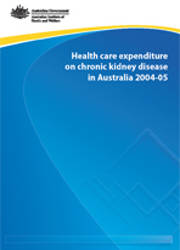Summary
Chronic kidney disease (CKD) is a common and serious problem in Australia and its management can be resource intensive. Those with CKD's most severe form, end-stage kidney disease, usually require dialysis or a kidney transplant to survive. Some forms of dialysis require regular and frequent hospital admissions and dialysis is the most common reason for hospitalisation in Australia.
Health care expenditure on chronic kidney disease 2004-05 is the first full report on health care expenditure for CKD in Australia, and revises estimates reported in Chronic kidney disease in Australia 2005. Expenditure estimates in this report were derived from the Australian Institute of Health and Welfare (AIHW) Disease Expenditure Database and include only the direct health care costs that were able to be allocated by disease.
Key findings
- CKD is a substantial contributor to health care expenditure in Australia, accounting for 1.7% of total expenditure.
- Expenditure on CKD is increasing much faster than total health care expenditure.
The figures
Substantial contributor
- Health care expenditure on CKD in Australia in 2004-05 was $898.7 million.
- Nearly 85% ($760 million) of CKD expenditure was due to dialysis and transplant, with dialysis alone accounting for around two-thirds (over $593 million).
Expenditure increasing
- Between 2000-01 and 2004-05 expenditure on CKD increased from 1.3% to 1.7% of the total allocated health care expenditure.
- After adjusting for inflation, this was a 33% increase, whereas total health care expenditure increased by 19%.
- Expenditure on CKD per person in Australia increased by 27%, more than double the increase in per person total health care expenditure.
Preliminary material: Acknowledgments
1. Introduction
- Purpose
- Background
- What is health expenditure?
2. Methods and limitations
- Data used to provide estimates
- Changes in methods between 2000-01 and 2004-05
3. How much is spent on chronic kidney disease?
4. Treatment of end-stage kidney disease
5. Changes in health care expenditure, 2000-01 to 2004-05
6. Discussion and conclusion
Appendixes
Appendix 1: Data and methods used to provide estimates
Appendix 2: Defining CKD
End matter: Glossary; References



